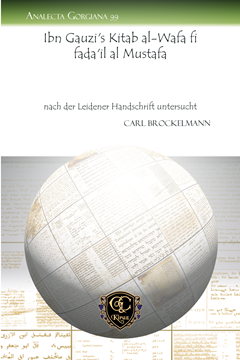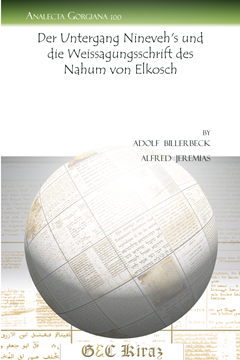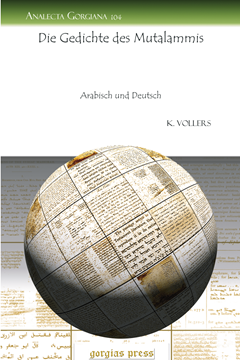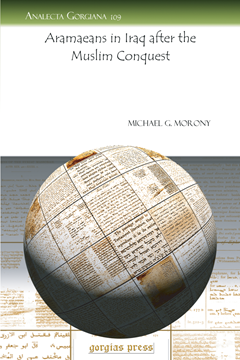Ibn Gauzi’s Kitab al-Wafa fi fada’il al Mustafa
nach der Leidener Handschrift untersucht
Series: Analecta Gorgiana 99
ISBN: 978-1-60724-023-5
This investigation of Abu-al-Faraj Ibn al-Jawzi’s al-Wafa bi Fada'il al-Mustafa, according to the Leiden manuscript by one of Germany’s foremost Semiticists, is essential reading for anyone interested in Arabic history and literature. Ibn al-Jawzi was a twelfth-century jurist and perhaps the most prolific writer in the history of Arabic literature. Al-Wafa bi Fada'il al-Mustafa (Detailed Accounts of the Chosen Prophet), is a large work on the biography of the prophet Muhammad. In this manuscript study, Brockelmann analyzes several aspects of this composition, including citations of this work by other notable Islamic writers.
$45.00 (USD) $27.00 (USD)
Der Untergang Nineveh’s und die Weissagungsschrift des Nahum von Elkosch
Series: Analecta Gorgiana 100
ISBN: 978-1-60724-024-2
An elaborate historical treatise on the fall of Nineveh and the writings of the prophet Nahum, this work is divided into three chapters. The first contains a translation of Nahum’s oracle against Nineveh with both historical and Assyriological commentaries. The second chapter is a history and description of the city of Nineveh from earliest times to its downfall. A brief but interesting discussion of the origin and development of the Medes as a people closes the second chapter. The final chapter is an archaeological and scientific military description of ancient Assyrian fortifications and a treatise on their use in the warfare of the period.
$56.00 (USD) $33.60 (USD)
Die Briefe Hammurabi’s an Sin-Idinnam
Series: Analecta Gorgiana 101
ISBN: 978-1-60724-025-9
In keeping with the general format of nineteenth-century Assyriological publications, this study provides an abundance of information on the texts under consideration. Here, the correspondence between the famous Babylonian king Hammurabi and the governor of Larsa, Sin-Idinnam, is examined in detail. Nagel also includes commentary, beginning with grammatical and syntactical issues. Next he turns to lexical issues, beginning with individual words, compound words, and ideograms. Friedrich Delitzsch also adds further remarks to Nagel’s adequate analysis of these historically significant texts.
$47.00 (USD) $28.20 (USD)
Die Gedichte des Mutalammis
Arabisch und Deutsch
By K. Vollers
Series: Analecta Gorgiana 104
ISBN: 978-1-60724-030-3
In this edition of the poems of Mutalammis, a 6th-century poet from the tribe of Bakr, Vollers draws on his extensive experience in Cairo to present an informative edition of the poems in both Arabic and German translation. After a substantial introduction to the material at hand, the Arabic texts, annotated, are presented. This is followed by the fragments that have survived and a translation of texts I to XVII. With this wealth of material, the interested reader of early Arabic poetry will find this edition of poems by Mutalammis a welcome edition to their library of Arabic literature.
$50.00 (USD) $30.00 (USD)
Hymnen und Gebete an Marduk
Series: Analecta Gorgiana 105
ISBN: 978-1-60724-031-0
In this widely cited study of the hymns and prayers to Marduk, Hehn has brought together a very useful resource for students of Babylonian religion. The genealogy of Marduk, his sphere of influence, his names and his role as a determiner of fate open the work. Marduk’s function as the protector of Babylon and his persona compared to the biblical idea of the divine, as well as the conflict with the dragon are addressed. There follow several texts that fit into the categories of hymns and prayers to Marduk. Each one is given in transliteration, translation, and with comments. The study concludes with line drawings of the individual tablets.
$59.00 (USD) $35.40 (USD)
Altbabylonische Urkunden aus Sippara
Texte mit Umschrift, Übersetzung und Kommentar
Series: Analecta Gorgiana 106
ISBN: 978-1-60724-032-7
Sippar had yielded thousands of clay tablets and these were still being published in this period. Texts are given in transliteration and translation, and commentary is included. The next section concerns the representation from seal impressions, those categorized by gods and those categorized by epic. A comparison of names and an overview of published cuneiform texts also play a role in the discussion. The texts are presented in line drawings and photographs of cylinder-seal impressions conclude the work.
$58.00 (USD) $34.80 (USD)
Purim
Address Delivered at the Annual Meeting of the Society of Biblical Literature and Exegesis
By Paul Haupt
Series: Analecta Gorgiana 107
ISBN: 978-1-60724-033-4
Approaching the question of Purim historically, Haupt notes that the book of Esther was composed during the reign of Judas Maccabeus, and he correlates the festival to the Babylonian New Year. He discusses the origin of the title “purim” from various languages, ultimately deciding on the Old Persian explanation. Moving forward, Haupt brings the festival into the more modern period, showing how the ancient tradition continues to exist. A useful resource for anyone interested in turn-of-the-century thought on the origins of an enigmatic biblical festival, this contribution is both readable to the layperson and scholarly as well.
$44.00 (USD) $26.40 (USD)
Umajja ibn Abi s Salt
Die unter seinem Namen Überlieferten Gedichtfragmente
Series: Analecta Gorgiana 108
ISBN: 978-1-60724-034-1
In this collection of poetry of Umayya ibn Abi al-Salt, as well as poems published in his name, Schulthess does a great service in bringing together these legendary Arabic poems. Umayya ibn Abi al-Salt was a contemporary of Muhammad who did not accept Islam. Printed here in the original Arabic, the poems are also translated in German and annotated. Schulthess also provides a knowledgeable introduction that includes a listing of the manuscript sources utilized in the reconstruction of the texts.
$63.00 (USD) $37.80 (USD)
Jews in Iraq after the Muslim Conquest
Series: Analecta Gorgiana 110
ISBN: 978-1-59333-601-1
As the oldest organized religion in Sassanian Iraq, Judaism serves as a kind of model for other religious organizations in the region. After considering the growth of Judaism in Iraq during the Sassanian period, Morony notes the connections between the Jewish and Aramaean populations as well as the intermixed ethnic communities in which Jews played a part. Social, administrative, and religious issues are all considered. Messianic expectations as they continued to develop in the Jewish community in diaspora round out this discussion of Judaism as a fully developed religion in Iraq under Islamic rule.
$36.00 (USD) $21.60 (USD)
Aramaeans in Iraq after the Muslim Conquest
Series: Analecta Gorgiana 109
ISBN: 978-1-59333-600-4
This extract from Michael G. Morony’s Iraq After The Muslim Conquest presents a brief yet through presentation of the complex language and political history of the Aramaeans of that region. The interaction of the Aramaeans and the Arabs during the period of the Islamic conquest is sketched out, citing the important families and individuals that stand out in this situation. The somewhat uneasy mutual relationship between the Arabs and Aramaeans is briefly explored.
$32.00 (USD) $19.20 (USD)









